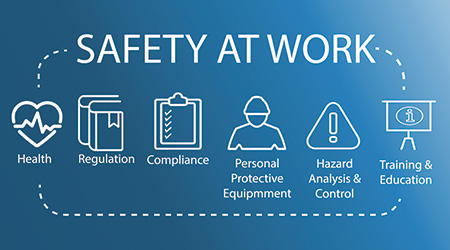
Contributed by BSCAI
As we enter another new year, many people are making resolutions for 2022. A common goal at the start of each year is to be healthier — including getting stronger and avoiding injuries that may cause nagging pain throughout the year. A dedicated safety program at work can go a long way toward helping people avoid accidents and achieve this goal.
The Building Service Contractors Association International (BSCAI) recently discussed the importance of workplace safety programs with Tom Covilli, vice president of safety and risk management at St. Louis-based 4M Building Solutions, as well as Gunter Langston and Dawn Weber, IH Services’ vice president of human resources and safety, and director of inclusion, learning and development, respectively, in Greenville, South Carolina. All three agreed that building service contractors (BSCs) looking to introduce or revamp safety programs should be mindful of the language they use in their program materials.
Covilli says 4M’s safety program existed before he began there in 2007, lauding founder Mitch Murch and CEO Tim Murch for their unwavering commitment to safety. When Covilli joined the company, he worked together with the operations department to modify the existing program and make it more proactive and structured. In redeveloping “Zero Path,” the safety program, the goal was to change the way 4M’s team members thought about safety, encouraging them to think about safety as more than just a box to check to avoid repercussions.
The redesigned Zero Path program breaks down into six different components:
- Establishing standards of performance
- Effectively communicating and promoting the program
- Training and educating all employees on safety
- Evaluating the success of the program
- Recognizing and celebrating success
- Incorporating changes when needed
“Over the years, the safety culture has evolved to where team members understand that safety is for their personal wellbeing, and not just words on a piece of paper,” Covilli explains.
Langston and Weber echoed a similar sentiment; safety should be seen as something positive and empowering, not negative. Langston spearheaded IH Services’ safety program, which officially launched in January 2011 after a 13-month development period. The program, called “12 Steps to Zero Accidents,” includes different aspects of education and training.
According to Weber, its “backbone” is comprised of 12 positive safety affirmations. Each month of the year is dedicated to one of the affirmations, and the affirmations build on each other throughout the year.
For example, in May, employees tell themselves that they are “expert[s] at identifying and communicating safety hazards.” Then, in July, employees tell themselves that they “will challenge [a situation] if it appears that [their] safety will be compromised.” In August, they vow to “intervene in any situation that appears unsafe.”
“We want to teach you to be an expert and then we want you to have the authority to stop work, to challenge if it looks to be unsafe, and then to go a step beyond and be an advocate and an asset within our customer sites,” Langston says.
Another important aspect of safety programs is accessibility, Covilli says. He points out that many employees in the contract cleaning industry are bilingual or multilingual, and that there can be high staff turnover in the industry. These realities can make maintaining a program challenging, but it is essential that all employees receive — and understand — the same safety training. Accordingly, BSCs looking to introduce or revamp safety programs should ensure it is available in multiple languages.
“Making sure we communicate well with [multilingual] team members, ensuring that they understand the principles of the program and that they know what we’re trying to accomplish” is one of the most important elements of Zero Path, Covilli says.
How To Market Your Safety Program To Employees

 The Down and Dirty on Cleaning in Virus Season
The Down and Dirty on Cleaning in Virus Season How Surfactant Use is Expanding in Commercial Cleaning
How Surfactant Use is Expanding in Commercial Cleaning